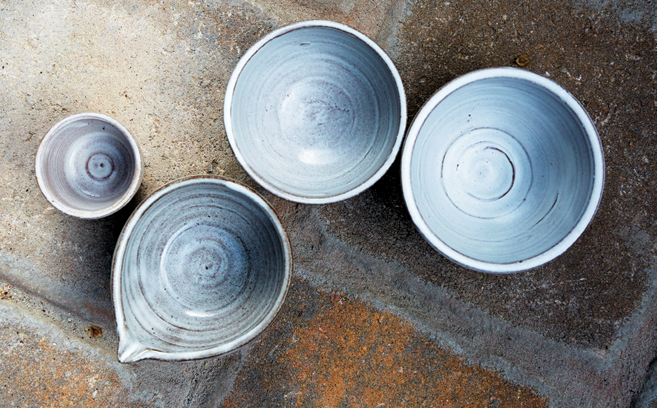Cooking Up Clay
The cappuccino is perfecto—how could it not be? Made by an honest-to-goodness Italian (the charming Mrs. Berardozzi); served in a lovely hand-crafted cup (made by her son); sipped in a beautiful backyard garden on Vanderhorst Street on a bright Charleston morning. The coffee conversation is funny and lively, as one might expect from creative types—a chef and two ceramic artists—talking shop in the open-air studio of Fiorenzo Berardozzi. Which is to say they talk cooking: the prepping, firing and “cooking” of clay.
“Chefs are makers. They’re tactile people. And we’re tactile artists,” says Berardozzi, speaking of himself and his colleague, Chip Burr, who are the eponymous initials behind CBFB Tablescapes, creators of custom ceramic tableware. “We’re all visual people,” he adds.
One day it simply dawned on Berardozzi and Burr, who had begun to get more and more commissions from restaurants like Husk, McCrady’s and the Drawing Room: Why not bring some chef friends into the studio and let them play around, show them what clay is like? “This is very much a kitchen to us,” says Berardozzi.
Indeed the similarities between what happens in a kitchen and what happens in a ceramics studio are striking, notes Ennio Vazquez, sous chef at The Vendue’s Drawing Room and a regular at Berardozzi’s studio.
“When I first saw Fiorenzo wedging a hunk of clay, I thought, wow, that’s just like making pasta, working the dough,” Vazquez says. Then of course there’s the kiln—putting raw ingredients in the “oven” to bake.
These backyard clay and coffee sessions have deepened the rapport and understanding between Charleston’s culinary artists creating food to put on restaurant plates, and those who create the plate. It’s a rapport that seems timely given today’s Instagram-hungry culture when the art of plating food is more important than ever, but the art of the plate itself has typically been overlooked. The vast majority of restaurants use bulk-manufactured plateware, “stuff that’s produced in an emotionally neutral environment,” says Berardozzi. But through CBFB Tablescapes, Berardozzi and Burr seek to marry simplicity and functionality while honoring both the plate and the food as nourishing body and soul.
FROM GROUND TO TABLE
Berardozzi and Burr never set out to be tableware artisans for James Beard Award-winning restaurants in Charleston and beyond (see sidebar). In fact, both were sculptural artists sharing studio space with other ceramicists at Cone10 Studios on Morrison Drive when Burr happened to have a conversation one day several years ago with his son-in-law, fisherman Mark Marhefka. Marhefka, whose Abundant Seafood supplies area chefs with fresh sustainable seafood, was telling Burr about Sean Brock’s plan to open Husk, which would highlight products from local purveyors—at the time one of Charleston’s first farm-to-table concepts.
“Yeah, but turn his plates over,” Burr challenged Marhefka. “I bet they’re made in China.”
Brock indeed was interested in extending his “locally sourced” concept to Husk’s tableware, and was eager to meet with Burr and Berardozzi. “He’d done a lot of research and showed us 150 photos of plates and glazes he’d been considering, then gave us a sample plate and asked us to replicate it,” Burr recalls. “But when we got back to the studio, Fiorenzo and I agreed the sample was nothing special, and was not what we’d just heard him describe. So we decided instead to make the plate we heard him say he wants.” They did, and Brock was sold.
A NEW DIRECTION
The Husk commission marked a shift for Burr and Berardozzi’s work. “I don’t think I’d made any functional piece before that,” admits Burr. But the two found they loved the challenge of creating tableware to reflect a chef’s sensibility. After the Husk order, Brock placed one for McCrady’s. As Brock’s profile steadily rose, so did demand for CBFB Tablespaces’ work. “People would come in the restaurant, experience the plates, then come visit our studio the next day,” says Burr.
Today tableware has become Berardozzi and Burr’s primary artistic focus. “When Chip and I design, we meet with the chef and are more concerned with finding out who they are, what their personality is, than we are with the color and texture, the shape and size of a plate,” says Berardozzi. “For example, Ennio here is Puerto Rican, a pretty energetic dude, so when designing for The Drawing Room we need to create plates that reflect and accommodate that. It can grow from there, then the story is relevant and can be expressed on the plate as the chef is plating.”
Just as chefs working with locally sourced ingredients seek to translate those flavors and that history and heritage into their food, Berardozzi and Burr seek to add an extra dimension of artistry and personality into the dining experience. Those local ingredients come from the ground, and so does the clay.
“We want to create a plate that the chef has a relationship with. Something unique, and not just a manufactured piece bought from a sales rep,” adds Burr. “We believe that helps him make the food better and create the conversation that wasn’t there before about the plate and the food and whole experience.”
PLAYING AND PLATING
When Vazquez met Berardozzi and Burr through a mutual friend, he knew their tableware would be perfect for the Drawing Room, which is part of an art-themed boutique hotel. CBFB Tablescapes is in the process of filling their order, and meanwhile, Vazquez enjoys coming to dabble in clay with Berardozzi and Burr (who will soon be relocating to Florida but continuing in the partnership). The sessions often slip into heady discourse on glazes and color theory (how a black plate absorbs color, how opposite colors paired side by side produce an intense neon edge effect), then with them all taking a break and firing up some chow.
“It’s a great balance, they (the chefs) can relax and enjoy trying out some recipes and techniques in a no-pressure situation, and we can all play around with clay,” says Berardozzi.
As the chef who does all the plating at the Drawing Room, Vazquez intimately knows each and every plate, and learning more about the art and science behind ceramics helps him appreciate both his creative process, as well as the ceramicists’. “I believe all crafts can really relate to each other,” he says.
Indeed appreciating the texture, color, weight and feel of a plate adds to the whole dining experience, suggests Berardozzi. “My ceramics professor was Japanese, and he talked about clay in terms of food. We eat with all the senses, and we make art with all the senses, so if you eliminate one of those, say texture, then the experience changes,” he explains. Each plate that CBFB creates is unique and, while tightly artistically controlled, a commissioned collection as a whole has a slightly unpredictable element. Which is intentional.
“If you have a preconceived notion of what something should look like or even taste like, then you lose out on that wonderful spark of creativity that comes with encountering the unexpected, if you’re open to it,” Berardozzi says. “These little variations give it personality, and invite you to have a relationship with it. That’s what local sourcing is really all about.”
PLATE DATE
Wondering where you can dine on CBFB plateware?
Locally:
Husk
McCrady’s
Ocean Room at The Sanctuary, Kiawah Island
Table and Tavern, Mt. Pleasant
492 FIG
Hen and the Goat
The Daily, Charleston
Butcher and Bee, Charleston & Nashville, TN
Farther Afield:
Hearth Stone Kitchen and Cellar, Las Vegas, Nevada
Rudy’s of the Cape, Cape Elizabeth, Maine
U.S. Department of the State, Washington, D.C.
Quince, San Francisco, California
Libertine Social, Las Vegas, Nevada
In Situ at SFMOMA, San Francisco, California









